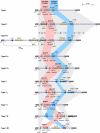Community-associated methicillin-resistant Staphylococcus aureus: epidemiology and clinical consequences of an emerging epidemic
- PMID: 20610826
- PMCID: PMC2901661
- DOI: 10.1128/CMR.00081-09
Community-associated methicillin-resistant Staphylococcus aureus: epidemiology and clinical consequences of an emerging epidemic
Abstract
Staphylococcus aureus is an important cause of skin and soft-tissue infections (SSTIs), endovascular infections, pneumonia, septic arthritis, endocarditis, osteomyelitis, foreign-body infections, and sepsis. Methicillin-resistant S. aureus (MRSA) isolates were once confined largely to hospitals, other health care environments, and patients frequenting these facilities. Since the mid-1990s, however, there has been an explosion in the number of MRSA infections reported in populations lacking risk factors for exposure to the health care system. This increase in the incidence of MRSA infection has been associated with the recognition of new MRSA clones known as community-associated MRSA (CA-MRSA). CA-MRSA strains differ from the older, health care-associated MRSA strains; they infect a different group of patients, they cause different clinical syndromes, they differ in antimicrobial susceptibility patterns, they spread rapidly among healthy people in the community, and they frequently cause infections in health care environments as well. This review details what is known about the epidemiology of CA-MRSA strains and the clinical spectrum of infectious syndromes associated with them that ranges from a commensal state to severe, overwhelming infection. It also addresses the therapy of these infections and strategies for their prevention.
Figures
References
-
- Abdel-Haq, N., H. Al-Tatari, P. Chearskul, H. Salimnia, B. I. Asmar, M. R. Fairfax, and M. Amjad. 2009. Methicillin-resistant Staphylococcus aureus (MRSA) in hospitalized children: correlation of molecular analysis with clinical presentation and antibiotic susceptibility testing (ABST) results. Eur. J. Clin. Microbiol. Infect. 28:547-551. - PubMed
-
- Abi-Hanna, P., A. L. Frank, J. P. Quinn, S. Kelkar, P. C. Schreckenberger, M. K. Hayden, and J. F. Marcinak. 2000. Clonal features of community-acquired methicillin-resistant Staphylococcus aureus in children. Clin. Infect. Dis. 30:630-631. - PubMed
-
- Adam, H., A. McGeer, and A. Simor. 2007. Fatal case of post-influenza community-associated MRSA pneumonia in an Ontario teenager with subsequent familial transmission. Can. Commun. Dis. Rep. 33:45-48. - PubMed
-
- Adcock, P., P. Pastor, F. Medley, J. Patterson, and T. Murphy. 1998. Methicillin-resistant Staphylococcus aureus in two childcare centers. J. Infect. Dis. 178:577-580. - PubMed
-
- Adedeji, A., T. M. A. Weller, and J. W. Gray. 2007. MRSA in children presenting to hospitals in Birmingham, UK. J. Hosp. Infect. 65:29-34. - PubMed
Publication types
MeSH terms
Substances
LinkOut - more resources
Full Text Sources
Other Literature Sources
Medical



